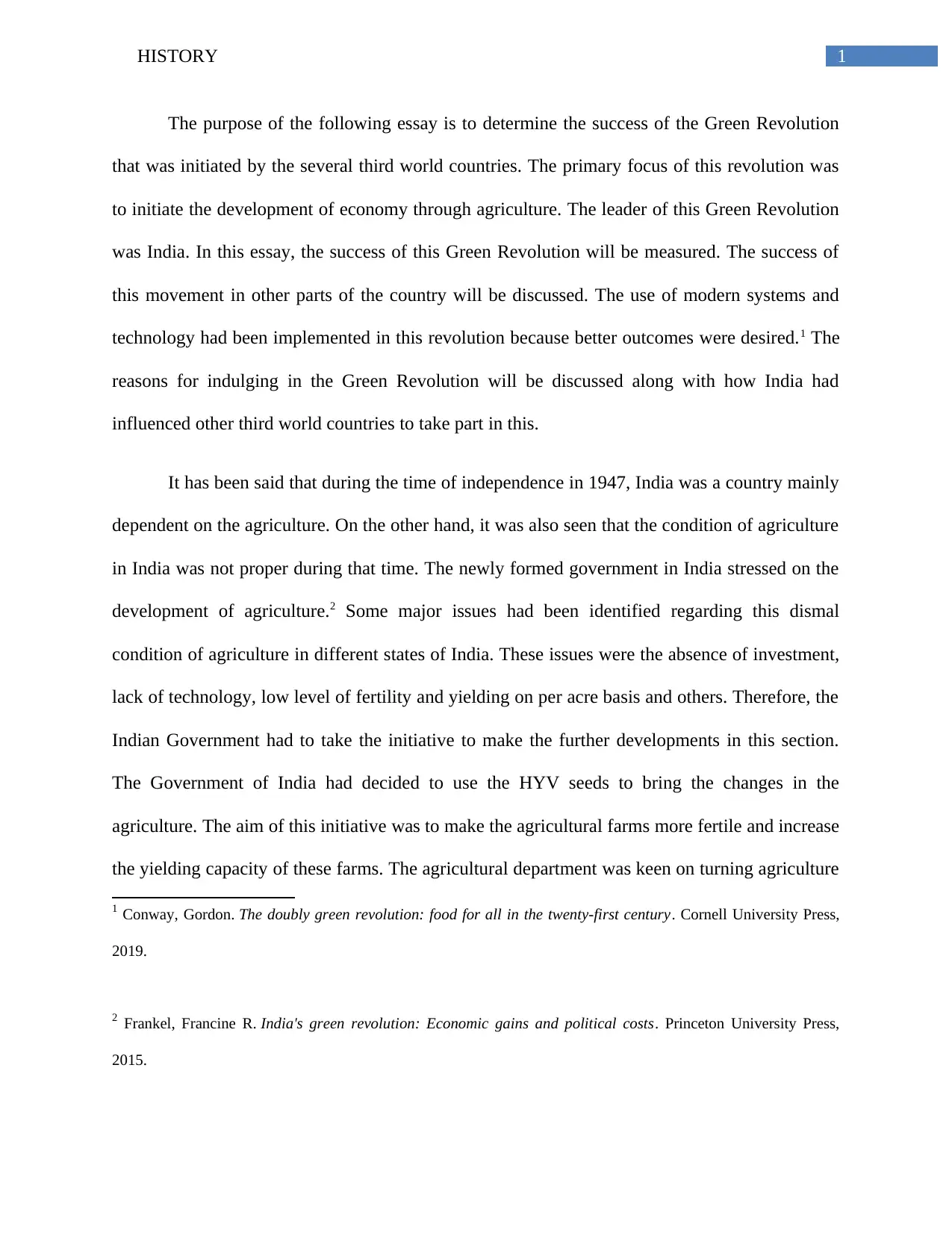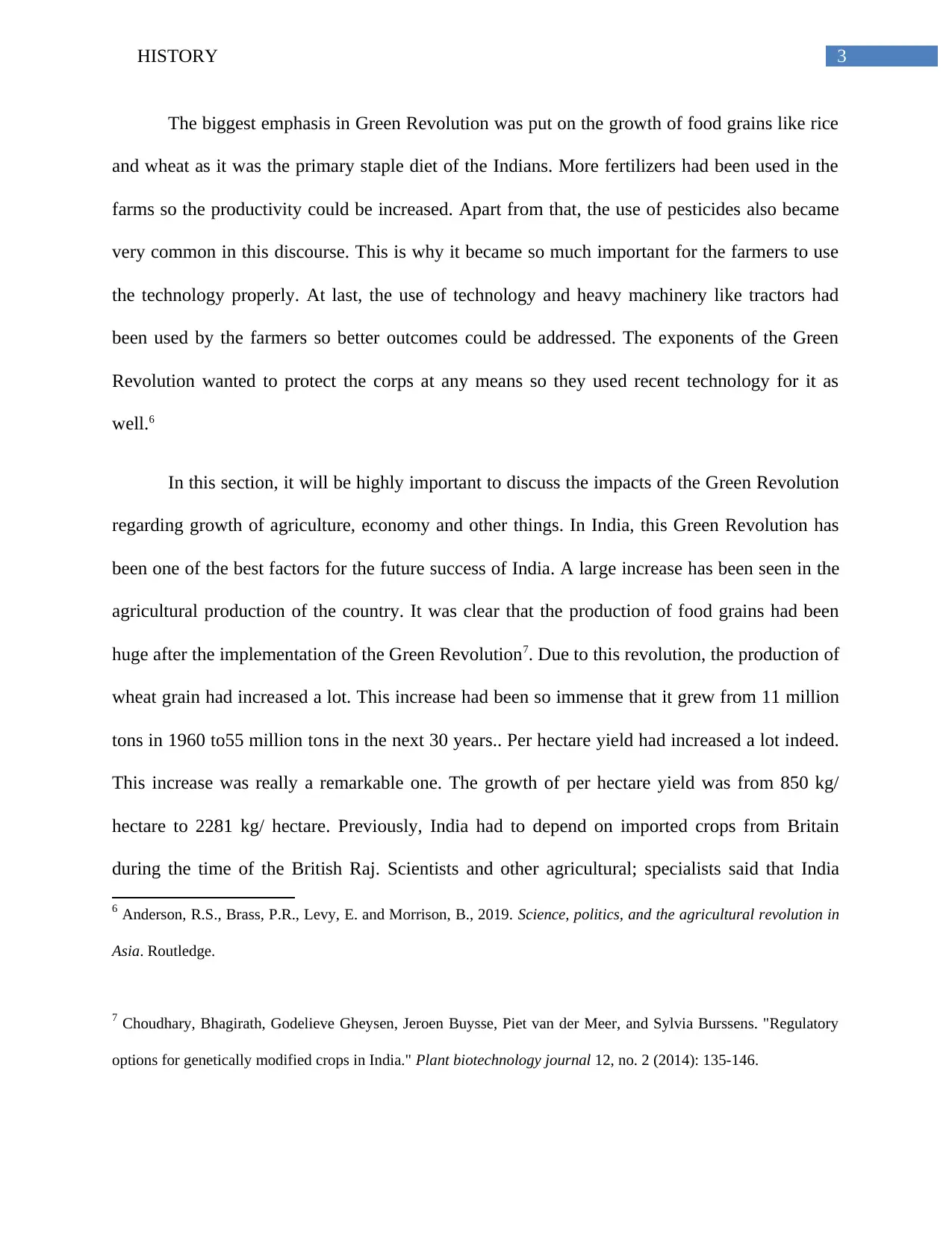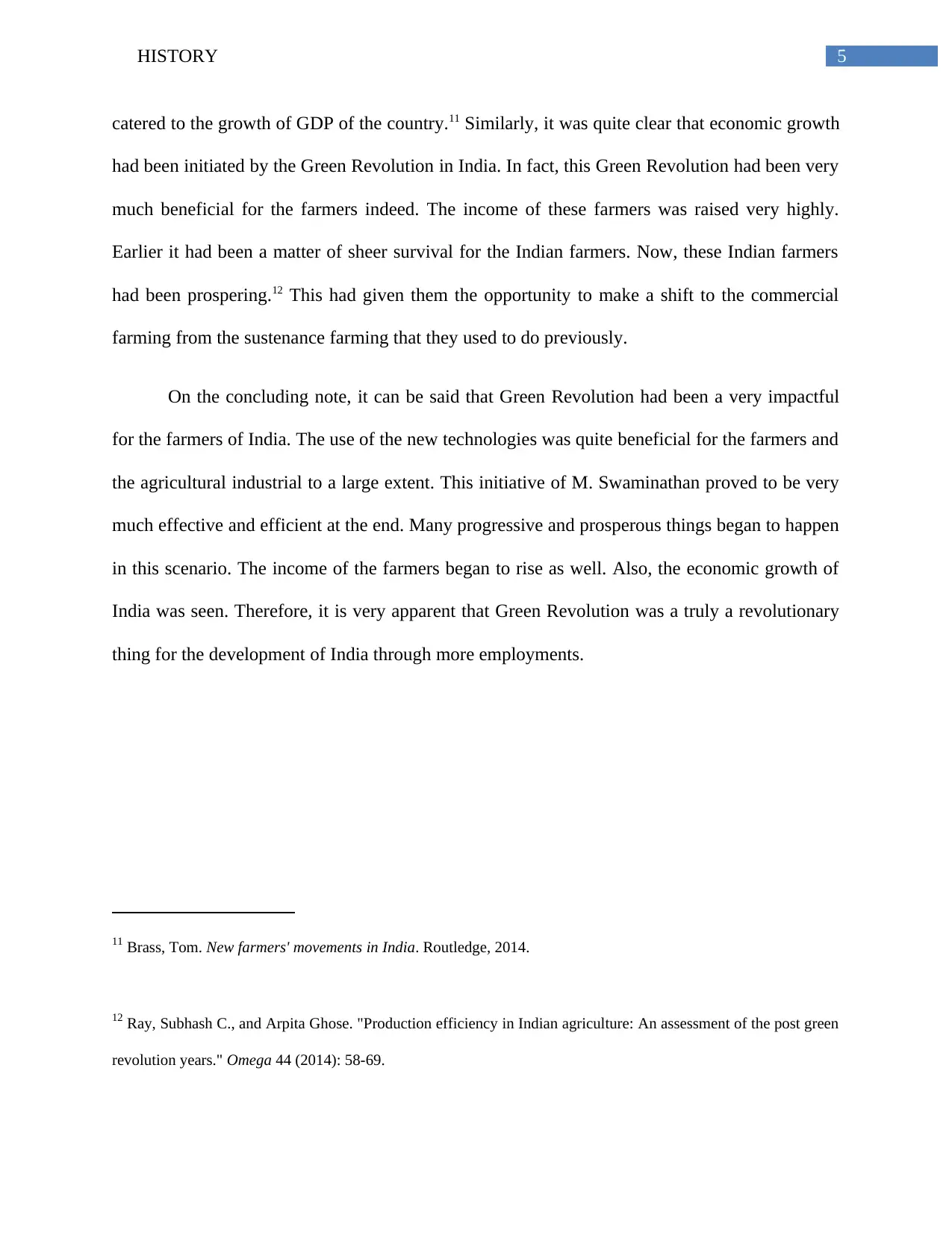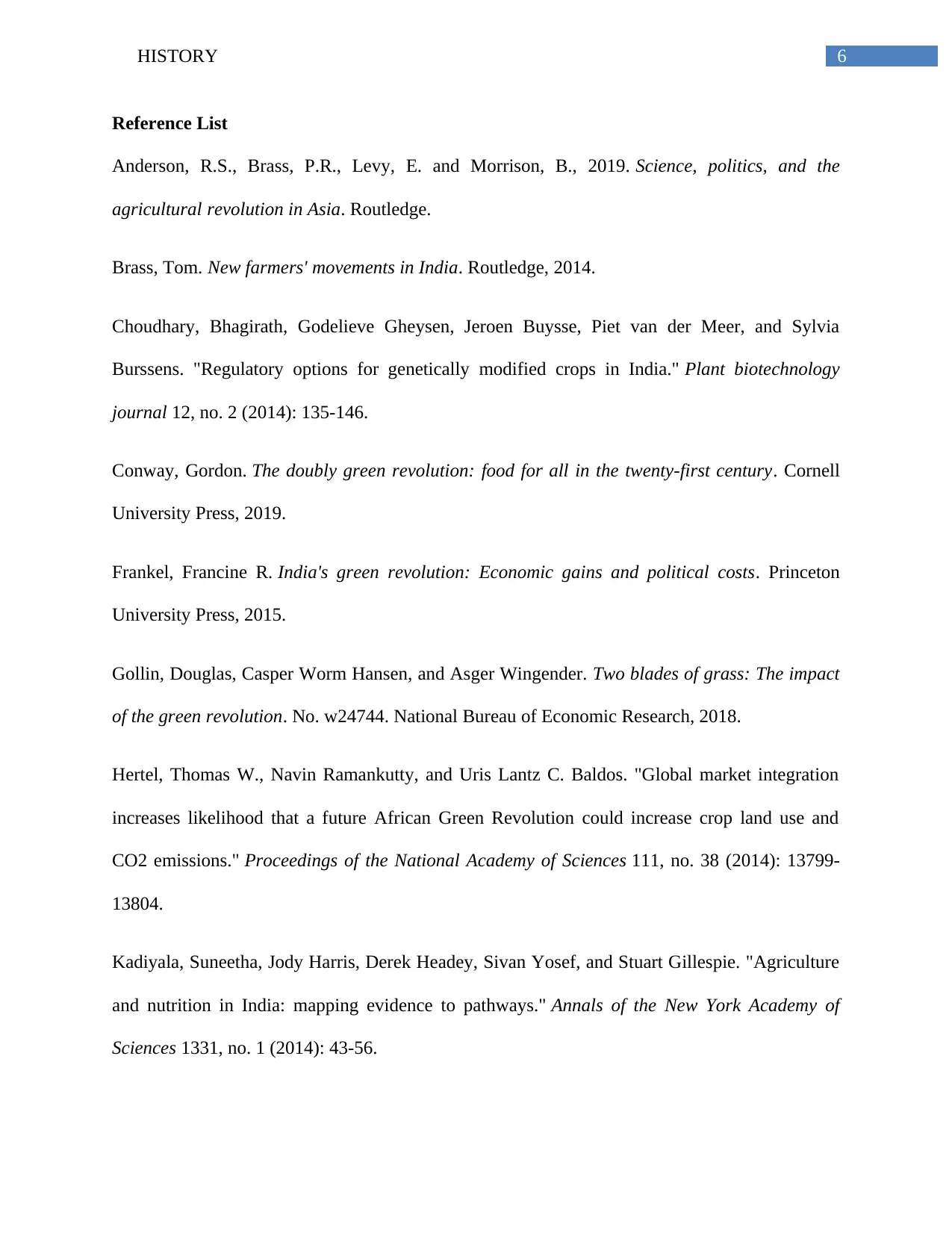History Term Paper: Assessing the Success of the Green Revolution
VerifiedAdded on 2023/01/10
|8
|1620
|51
Essay
AI Summary
This essay examines the success of the Green Revolution in India, initiated to boost agricultural development and economic growth. The essay details the government's initiatives, including the use of High Yielding Variety (HYV) seeds and improved irrigation, and the influence of M.S. Swaminathan. It highlights the revolution's impact on increased food production, particularly wheat and rice, leading to self-sufficiency and reduced dependence on imports. The essay also discusses the rise in employment due to the industrialization of agriculture and the resulting economic growth, which benefited farmers by increasing their income and enabling a shift to commercial farming. The analysis covers the use of technology, machinery, and fertilizers, as well as the social and economic impacts of the Green Revolution, concluding that it was a pivotal development for India's progress and development.

Running head: HISTORY
History
Name of the Student
Name of the University
Author Note
History
Name of the Student
Name of the University
Author Note
Paraphrase This Document
Need a fresh take? Get an instant paraphrase of this document with our AI Paraphraser

1HISTORY
The purpose of the following essay is to determine the success of the Green Revolution
that was initiated by the several third world countries. The primary focus of this revolution was
to initiate the development of economy through agriculture. The leader of this Green Revolution
was India. In this essay, the success of this Green Revolution will be measured. The success of
this movement in other parts of the country will be discussed. The use of modern systems and
technology had been implemented in this revolution because better outcomes were desired.1 The
reasons for indulging in the Green Revolution will be discussed along with how India had
influenced other third world countries to take part in this.
It has been said that during the time of independence in 1947, India was a country mainly
dependent on the agriculture. On the other hand, it was also seen that the condition of agriculture
in India was not proper during that time. The newly formed government in India stressed on the
development of agriculture.2 Some major issues had been identified regarding this dismal
condition of agriculture in different states of India. These issues were the absence of investment,
lack of technology, low level of fertility and yielding on per acre basis and others. Therefore, the
Indian Government had to take the initiative to make the further developments in this section.
The Government of India had decided to use the HYV seeds to bring the changes in the
agriculture. The aim of this initiative was to make the agricultural farms more fertile and increase
the yielding capacity of these farms. The agricultural department was keen on turning agriculture
1 Conway, Gordon. The doubly green revolution: food for all in the twenty-first century. Cornell University Press,
2019.
2 Frankel, Francine R. India's green revolution: Economic gains and political costs. Princeton University Press,
2015.
The purpose of the following essay is to determine the success of the Green Revolution
that was initiated by the several third world countries. The primary focus of this revolution was
to initiate the development of economy through agriculture. The leader of this Green Revolution
was India. In this essay, the success of this Green Revolution will be measured. The success of
this movement in other parts of the country will be discussed. The use of modern systems and
technology had been implemented in this revolution because better outcomes were desired.1 The
reasons for indulging in the Green Revolution will be discussed along with how India had
influenced other third world countries to take part in this.
It has been said that during the time of independence in 1947, India was a country mainly
dependent on the agriculture. On the other hand, it was also seen that the condition of agriculture
in India was not proper during that time. The newly formed government in India stressed on the
development of agriculture.2 Some major issues had been identified regarding this dismal
condition of agriculture in different states of India. These issues were the absence of investment,
lack of technology, low level of fertility and yielding on per acre basis and others. Therefore, the
Indian Government had to take the initiative to make the further developments in this section.
The Government of India had decided to use the HYV seeds to bring the changes in the
agriculture. The aim of this initiative was to make the agricultural farms more fertile and increase
the yielding capacity of these farms. The agricultural department was keen on turning agriculture
1 Conway, Gordon. The doubly green revolution: food for all in the twenty-first century. Cornell University Press,
2019.
2 Frankel, Francine R. India's green revolution: Economic gains and political costs. Princeton University Press,
2015.

2HISTORY
into an industrial system so people could get employment opportunities and increase the GDP
growth of the country.3
The Green Revolution had begun in the year 1965 and the use of High Yielding Variety
(HYV) seeds came to be formulated all across the country. Better and more efficient irrigation
facilities had also been managed in this situation as well.4 India had the responsibility of building
their economy in the most efficient ways all over again. This is why they had to take certain
strategies so the situations could be made better. During the times of British raj, India had faced
several famines. This had weakened their infrastructure completely. After all these barriers, India
went on to explore this Green Revolution by M.S. Swaminathan. It is quite important to discuss
some of the features of Green Revolution. Critics have highlighted the fact these HYV seeds had
been distributed across states like Punjab and Tamil Nadu since these states had good
infrastructure regarding irrigation facilities.5 Besides that, these seeds had been very much
successful with wheat crops. After the success in the first stage, these HYV seeds had been
distributed across several other states as well.
3 Kadiyala, Suneetha, Jody Harris, Derek Headey, Sivan Yosef, and Stuart Gillespie. "Agriculture and nutrition in
India: mapping evidence to pathways." Annals of the New York Academy of Sciences 1331, no. 1 (2014): 43-56.
4 Frankel, Francine R. India's green revolution: Economic gains and political costs. Princeton University Press,
2015.
5 Gollin, Douglas, Casper Worm Hansen, and Asger Wingender. Two blades of grass: The impact of the green
revolution. No. w24744. National Bureau of Economic Research, 2018.
into an industrial system so people could get employment opportunities and increase the GDP
growth of the country.3
The Green Revolution had begun in the year 1965 and the use of High Yielding Variety
(HYV) seeds came to be formulated all across the country. Better and more efficient irrigation
facilities had also been managed in this situation as well.4 India had the responsibility of building
their economy in the most efficient ways all over again. This is why they had to take certain
strategies so the situations could be made better. During the times of British raj, India had faced
several famines. This had weakened their infrastructure completely. After all these barriers, India
went on to explore this Green Revolution by M.S. Swaminathan. It is quite important to discuss
some of the features of Green Revolution. Critics have highlighted the fact these HYV seeds had
been distributed across states like Punjab and Tamil Nadu since these states had good
infrastructure regarding irrigation facilities.5 Besides that, these seeds had been very much
successful with wheat crops. After the success in the first stage, these HYV seeds had been
distributed across several other states as well.
3 Kadiyala, Suneetha, Jody Harris, Derek Headey, Sivan Yosef, and Stuart Gillespie. "Agriculture and nutrition in
India: mapping evidence to pathways." Annals of the New York Academy of Sciences 1331, no. 1 (2014): 43-56.
4 Frankel, Francine R. India's green revolution: Economic gains and political costs. Princeton University Press,
2015.
5 Gollin, Douglas, Casper Worm Hansen, and Asger Wingender. Two blades of grass: The impact of the green
revolution. No. w24744. National Bureau of Economic Research, 2018.
⊘ This is a preview!⊘
Do you want full access?
Subscribe today to unlock all pages.

Trusted by 1+ million students worldwide

3HISTORY
The biggest emphasis in Green Revolution was put on the growth of food grains like rice
and wheat as it was the primary staple diet of the Indians. More fertilizers had been used in the
farms so the productivity could be increased. Apart from that, the use of pesticides also became
very common in this discourse. This is why it became so much important for the farmers to use
the technology properly. At last, the use of technology and heavy machinery like tractors had
been used by the farmers so better outcomes could be addressed. The exponents of the Green
Revolution wanted to protect the corps at any means so they used recent technology for it as
well.6
In this section, it will be highly important to discuss the impacts of the Green Revolution
regarding growth of agriculture, economy and other things. In India, this Green Revolution has
been one of the best factors for the future success of India. A large increase has been seen in the
agricultural production of the country. It was clear that the production of food grains had been
huge after the implementation of the Green Revolution7. Due to this revolution, the production of
wheat grain had increased a lot. This increase had been so immense that it grew from 11 million
tons in 1960 to55 million tons in the next 30 years.. Per hectare yield had increased a lot indeed.
This increase was really a remarkable one. The growth of per hectare yield was from 850 kg/
hectare to 2281 kg/ hectare. Previously, India had to depend on imported crops from Britain
during the time of the British Raj. Scientists and other agricultural; specialists said that India
6 Anderson, R.S., Brass, P.R., Levy, E. and Morrison, B., 2019. Science, politics, and the agricultural revolution in
Asia. Routledge.
7 Choudhary, Bhagirath, Godelieve Gheysen, Jeroen Buysse, Piet van der Meer, and Sylvia Burssens. "Regulatory
options for genetically modified crops in India." Plant biotechnology journal 12, no. 2 (2014): 135-146.
The biggest emphasis in Green Revolution was put on the growth of food grains like rice
and wheat as it was the primary staple diet of the Indians. More fertilizers had been used in the
farms so the productivity could be increased. Apart from that, the use of pesticides also became
very common in this discourse. This is why it became so much important for the farmers to use
the technology properly. At last, the use of technology and heavy machinery like tractors had
been used by the farmers so better outcomes could be addressed. The exponents of the Green
Revolution wanted to protect the corps at any means so they used recent technology for it as
well.6
In this section, it will be highly important to discuss the impacts of the Green Revolution
regarding growth of agriculture, economy and other things. In India, this Green Revolution has
been one of the best factors for the future success of India. A large increase has been seen in the
agricultural production of the country. It was clear that the production of food grains had been
huge after the implementation of the Green Revolution7. Due to this revolution, the production of
wheat grain had increased a lot. This increase had been so immense that it grew from 11 million
tons in 1960 to55 million tons in the next 30 years.. Per hectare yield had increased a lot indeed.
This increase was really a remarkable one. The growth of per hectare yield was from 850 kg/
hectare to 2281 kg/ hectare. Previously, India had to depend on imported crops from Britain
during the time of the British Raj. Scientists and other agricultural; specialists said that India
6 Anderson, R.S., Brass, P.R., Levy, E. and Morrison, B., 2019. Science, politics, and the agricultural revolution in
Asia. Routledge.
7 Choudhary, Bhagirath, Godelieve Gheysen, Jeroen Buysse, Piet van der Meer, and Sylvia Burssens. "Regulatory
options for genetically modified crops in India." Plant biotechnology journal 12, no. 2 (2014): 135-146.
Paraphrase This Document
Need a fresh take? Get an instant paraphrase of this document with our AI Paraphraser

4HISTORY
needed to be self-sufficient because it was a huge country and it had to progress. Through this
course, India was slowly progressing towards self-sufficiency. Slowly India was beginning not to
depend upon other countries for their crops.8
Apparently, the officials of the agriculture department believed that the production of
crops was so much that they couild very easily bold up the stock for the people of India. If
emergencies occurred, this factor would surely save the people from spending too much money
on imported food crops and grains. Thus the dependence on other countries for the food was
reduced. After sometime, the situation turned to a level where India began to explore their
agricultural products to nearby small countries. Another impact that India felt in this discourse
was that of employment. Initially, there was a fear that the commercial farming would decrease
the rate of employment in India.9 However, the situation was turned completely. The rate of rural
employment had increased a lot in this scenario.
As a result of the industrialization of the agriculture, many supporting industries had been
formed. These industries were transportation, irrigation, marketing, food processing and others.
This is why many young people got jobs in these industries.10 This rise in the employment
8 Shiva, Vandana. The violence of the green revolution: Third world agriculture, ecology, and politics. University
Press of Kentucky, 2016.
9 Hertel, Thomas W., Navin Ramankutty, and Uris Lantz C. Baldos. "Global market integration increases likelihood
that a future African Green Revolution could increase crop land use and CO2 emissions." Proceedings of the
National Academy of Sciences 111, no. 38 (2014): 13799-13804.
10 Anderson, R.S., Brass, P.R., Levy, E. and Morrison, B., 2019. Science, politics, and the agricultural revolution in
Asia. Routledge.
needed to be self-sufficient because it was a huge country and it had to progress. Through this
course, India was slowly progressing towards self-sufficiency. Slowly India was beginning not to
depend upon other countries for their crops.8
Apparently, the officials of the agriculture department believed that the production of
crops was so much that they couild very easily bold up the stock for the people of India. If
emergencies occurred, this factor would surely save the people from spending too much money
on imported food crops and grains. Thus the dependence on other countries for the food was
reduced. After sometime, the situation turned to a level where India began to explore their
agricultural products to nearby small countries. Another impact that India felt in this discourse
was that of employment. Initially, there was a fear that the commercial farming would decrease
the rate of employment in India.9 However, the situation was turned completely. The rate of rural
employment had increased a lot in this scenario.
As a result of the industrialization of the agriculture, many supporting industries had been
formed. These industries were transportation, irrigation, marketing, food processing and others.
This is why many young people got jobs in these industries.10 This rise in the employment
8 Shiva, Vandana. The violence of the green revolution: Third world agriculture, ecology, and politics. University
Press of Kentucky, 2016.
9 Hertel, Thomas W., Navin Ramankutty, and Uris Lantz C. Baldos. "Global market integration increases likelihood
that a future African Green Revolution could increase crop land use and CO2 emissions." Proceedings of the
National Academy of Sciences 111, no. 38 (2014): 13799-13804.
10 Anderson, R.S., Brass, P.R., Levy, E. and Morrison, B., 2019. Science, politics, and the agricultural revolution in
Asia. Routledge.

5HISTORY
catered to the growth of GDP of the country.11 Similarly, it was quite clear that economic growth
had been initiated by the Green Revolution in India. In fact, this Green Revolution had been very
much beneficial for the farmers indeed. The income of these farmers was raised very highly.
Earlier it had been a matter of sheer survival for the Indian farmers. Now, these Indian farmers
had been prospering.12 This had given them the opportunity to make a shift to the commercial
farming from the sustenance farming that they used to do previously.
On the concluding note, it can be said that Green Revolution had been a very impactful
for the farmers of India. The use of the new technologies was quite beneficial for the farmers and
the agricultural industrial to a large extent. This initiative of M. Swaminathan proved to be very
much effective and efficient at the end. Many progressive and prosperous things began to happen
in this scenario. The income of the farmers began to rise as well. Also, the economic growth of
India was seen. Therefore, it is very apparent that Green Revolution was a truly a revolutionary
thing for the development of India through more employments.
11 Brass, Tom. New farmers' movements in India. Routledge, 2014.
12 Ray, Subhash C., and Arpita Ghose. "Production efficiency in Indian agriculture: An assessment of the post green
revolution years." Omega 44 (2014): 58-69.
catered to the growth of GDP of the country.11 Similarly, it was quite clear that economic growth
had been initiated by the Green Revolution in India. In fact, this Green Revolution had been very
much beneficial for the farmers indeed. The income of these farmers was raised very highly.
Earlier it had been a matter of sheer survival for the Indian farmers. Now, these Indian farmers
had been prospering.12 This had given them the opportunity to make a shift to the commercial
farming from the sustenance farming that they used to do previously.
On the concluding note, it can be said that Green Revolution had been a very impactful
for the farmers of India. The use of the new technologies was quite beneficial for the farmers and
the agricultural industrial to a large extent. This initiative of M. Swaminathan proved to be very
much effective and efficient at the end. Many progressive and prosperous things began to happen
in this scenario. The income of the farmers began to rise as well. Also, the economic growth of
India was seen. Therefore, it is very apparent that Green Revolution was a truly a revolutionary
thing for the development of India through more employments.
11 Brass, Tom. New farmers' movements in India. Routledge, 2014.
12 Ray, Subhash C., and Arpita Ghose. "Production efficiency in Indian agriculture: An assessment of the post green
revolution years." Omega 44 (2014): 58-69.
⊘ This is a preview!⊘
Do you want full access?
Subscribe today to unlock all pages.

Trusted by 1+ million students worldwide

6HISTORY
Reference List
Anderson, R.S., Brass, P.R., Levy, E. and Morrison, B., 2019. Science, politics, and the
agricultural revolution in Asia. Routledge.
Brass, Tom. New farmers' movements in India. Routledge, 2014.
Choudhary, Bhagirath, Godelieve Gheysen, Jeroen Buysse, Piet van der Meer, and Sylvia
Burssens. "Regulatory options for genetically modified crops in India." Plant biotechnology
journal 12, no. 2 (2014): 135-146.
Conway, Gordon. The doubly green revolution: food for all in the twenty-first century. Cornell
University Press, 2019.
Frankel, Francine R. India's green revolution: Economic gains and political costs. Princeton
University Press, 2015.
Gollin, Douglas, Casper Worm Hansen, and Asger Wingender. Two blades of grass: The impact
of the green revolution. No. w24744. National Bureau of Economic Research, 2018.
Hertel, Thomas W., Navin Ramankutty, and Uris Lantz C. Baldos. "Global market integration
increases likelihood that a future African Green Revolution could increase crop land use and
CO2 emissions." Proceedings of the National Academy of Sciences 111, no. 38 (2014): 13799-
13804.
Kadiyala, Suneetha, Jody Harris, Derek Headey, Sivan Yosef, and Stuart Gillespie. "Agriculture
and nutrition in India: mapping evidence to pathways." Annals of the New York Academy of
Sciences 1331, no. 1 (2014): 43-56.
Reference List
Anderson, R.S., Brass, P.R., Levy, E. and Morrison, B., 2019. Science, politics, and the
agricultural revolution in Asia. Routledge.
Brass, Tom. New farmers' movements in India. Routledge, 2014.
Choudhary, Bhagirath, Godelieve Gheysen, Jeroen Buysse, Piet van der Meer, and Sylvia
Burssens. "Regulatory options for genetically modified crops in India." Plant biotechnology
journal 12, no. 2 (2014): 135-146.
Conway, Gordon. The doubly green revolution: food for all in the twenty-first century. Cornell
University Press, 2019.
Frankel, Francine R. India's green revolution: Economic gains and political costs. Princeton
University Press, 2015.
Gollin, Douglas, Casper Worm Hansen, and Asger Wingender. Two blades of grass: The impact
of the green revolution. No. w24744. National Bureau of Economic Research, 2018.
Hertel, Thomas W., Navin Ramankutty, and Uris Lantz C. Baldos. "Global market integration
increases likelihood that a future African Green Revolution could increase crop land use and
CO2 emissions." Proceedings of the National Academy of Sciences 111, no. 38 (2014): 13799-
13804.
Kadiyala, Suneetha, Jody Harris, Derek Headey, Sivan Yosef, and Stuart Gillespie. "Agriculture
and nutrition in India: mapping evidence to pathways." Annals of the New York Academy of
Sciences 1331, no. 1 (2014): 43-56.
Paraphrase This Document
Need a fresh take? Get an instant paraphrase of this document with our AI Paraphraser

7HISTORY
Ray, Subhash C., and Arpita Ghose. "Production efficiency in Indian agriculture: An assessment
of the post green revolution years." Omega 44 (2014): 58-69.
Shiva, Vandana. The violence of the green revolution: Third world agriculture, ecology, and
politics. University Press of Kentucky, 2016.
Ray, Subhash C., and Arpita Ghose. "Production efficiency in Indian agriculture: An assessment
of the post green revolution years." Omega 44 (2014): 58-69.
Shiva, Vandana. The violence of the green revolution: Third world agriculture, ecology, and
politics. University Press of Kentucky, 2016.
1 out of 8
Related Documents
Your All-in-One AI-Powered Toolkit for Academic Success.
+13062052269
info@desklib.com
Available 24*7 on WhatsApp / Email
![[object Object]](/_next/static/media/star-bottom.7253800d.svg)
Unlock your academic potential
Copyright © 2020–2025 A2Z Services. All Rights Reserved. Developed and managed by ZUCOL.




